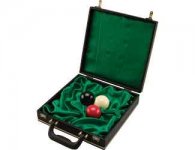Good question, from a technical standpoint I don't know what the numbers represent, maybe it's just a product number but the Simonis website probably explains it. From a practical standpoint the 760 is a finer textured surface and the ball rolls farther with less power than on 860, more like a billiard table. The difference that I notice is how the balls spread out on 760 as opposed to 860. It's not so much that the balls travel a lot further on a breakshot although that's part of it, it's more that they don't clump together as tightly and many times that 1/2 of space between the balls makes balls passable so they have paths to pockets without being moved again. It also helps me in that anytime I can hit a ball with less power I seem to be more accurate.
I never thought that much about playing conditions until I started playing more 14.1 and got my own table. Things like having the balls clean and polished that didn't seem that important before suddenly are noticeable. You would be amazed how much better a clean and shiny cue ball responds compared to one that is covered with chalk dust and grime. It's disappointing to me that the pool halls I play in won't spend the money to have ball washers and the balls and tables are often dirty. I used to think that none of this mattered because if you were playing an opponent you were both playing on the same equipment so who cared; but when trying to run balls and play 14.1 (even at my crappy level of play) it really helps to have the balls respond consistently because you are playing position around a lot of "traffic" on the lower rail and in the rack area. Those tiny little angles become very important and the difference between rolling a little too far or not quite far enough can be the difference between having multiple shots or no shot. It never ceases to amaze me that in 14.1 with balls spread out all over how often you can end up in one of the few spots where there is no easy shot. I spend a lot of time talking to the cueball, I hope that someday it will listen to me.
I never thought that much about playing conditions until I started playing more 14.1 and got my own table. Things like having the balls clean and polished that didn't seem that important before suddenly are noticeable. You would be amazed how much better a clean and shiny cue ball responds compared to one that is covered with chalk dust and grime. It's disappointing to me that the pool halls I play in won't spend the money to have ball washers and the balls and tables are often dirty. I used to think that none of this mattered because if you were playing an opponent you were both playing on the same equipment so who cared; but when trying to run balls and play 14.1 (even at my crappy level of play) it really helps to have the balls respond consistently because you are playing position around a lot of "traffic" on the lower rail and in the rack area. Those tiny little angles become very important and the difference between rolling a little too far or not quite far enough can be the difference between having multiple shots or no shot. It never ceases to amaze me that in 14.1 with balls spread out all over how often you can end up in one of the few spots where there is no easy shot. I spend a lot of time talking to the cueball, I hope that someday it will listen to me.
